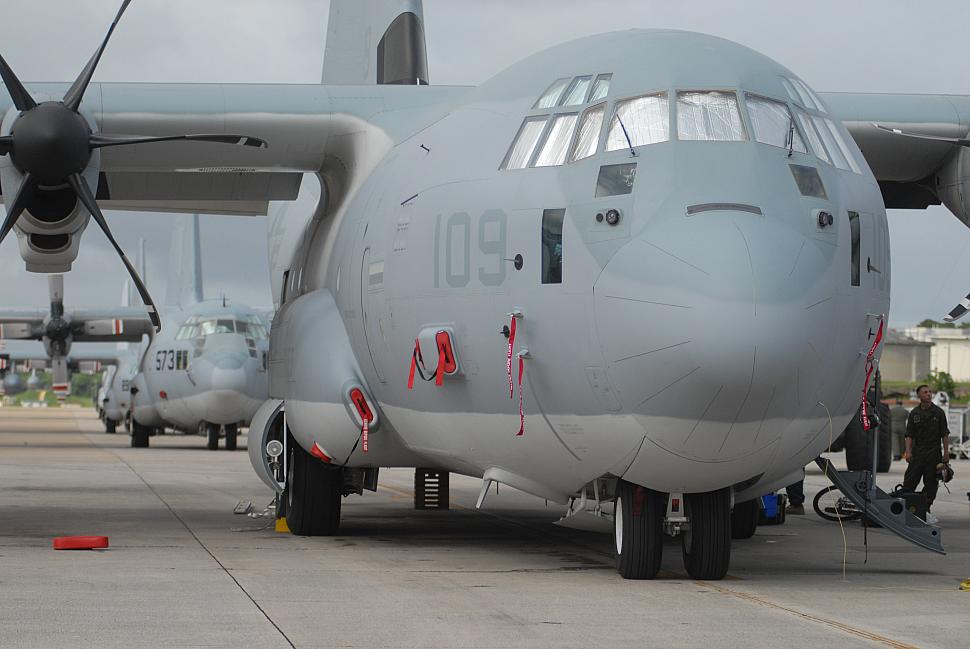C-130 News
C-130 Hercules News
VMGR-152 Receives Its First KC-130J
June 4, 2007 (by
Lance Cpl. Corey A. Blodgett - USMC) -
At Marine Corps Air Station Futenma, Okinawa, Japan Marine Aerial Refueler Transport Squadron 152 received its first KC-130J (#167109) Super Hercules June 4, 2007 as the high-tech airplane touched down on the runway.

Over the next 18 months, nine new aircraft will replace the older KC-130 models, most of which date back to the early 1960s, said Lt. Col. Dwight C. Neeley, the commanding officer of VMGR-152.
In fact, one of the aircraft to be replaced was the first KC-130 purchased by the Marine Corps and is the oldest in the Navy and Marine Corps inventory, he said.
"I'm beyond excited," he said. "We've worked very hard well over a year to try and make (the conversion) possible," he said. "The engines, propellers and avionics systems are so much more advanced. It allows us to fly these planes a lot more than we can the planes that are 40 years old."
Maintaining the aged KC-130s was becoming time-consuming and costly, according to Lt. Col. John M. Peck, the executive officer of VMGR-152.
"It costs a lot more to maintain and keep the old KC-130s running where they should be," Peck said. "The (KC-130Js) are a lot easier to maintain and will definitely save (the Marine Corps) money."
Along with saving the Marine Corps money, the new fuel efficient model's capabilities far surpass those of the old KC- 130s, Neeley explained. The new aircraft has a carrying capacity of 21.7 tons, max cruise speed of 408 mph, and max un-refueled range of 2,739 miles with an 18-ton payload.
The new planes feature state-of-the-art avionics equipment and a computerized cockpit with Heads-Up Displays that provide pilots with an extraordinary amount of information, said Maj. Kenneth L. Asbridge, a pilot on the new KC-130J.
"There's so much information at the pilot's fingertips, I can't even begin to explain," Asbridge said. "In the old plane, we were literally flying by the seat of our pants. Now we are monitoring computers and every thing is very exact."
He also said the plane is much faster because the new six-blade propellers, which provide up to 25 percent more horsepower, and the air-to-air refueling system boasts a fuel flow rate double that of its predecessor.
Even with all the advanced technology, Asbridge said that sometimes just the feel of a plane is important and the KC-130J definitely passed that test. "The old one handles like an old Cadillac, but this one is like a sports car," he said.

USMC KC-130J #167109 of VMGR-152 sits in front of one of the first KC-130s (#147573) bought by the Marine Corps in 1961. Photo goes with news story on June 8, 2007. [USMC photo]
In fact, one of the aircraft to be replaced was the first KC-130 purchased by the Marine Corps and is the oldest in the Navy and Marine Corps inventory, he said.
"I'm beyond excited," he said. "We've worked very hard well over a year to try and make (the conversion) possible," he said. "The engines, propellers and avionics systems are so much more advanced. It allows us to fly these planes a lot more than we can the planes that are 40 years old."
Maintaining the aged KC-130s was becoming time-consuming and costly, according to Lt. Col. John M. Peck, the executive officer of VMGR-152.
"It costs a lot more to maintain and keep the old KC-130s running where they should be," Peck said. "The (KC-130Js) are a lot easier to maintain and will definitely save (the Marine Corps) money."
Along with saving the Marine Corps money, the new fuel efficient model's capabilities far surpass those of the old KC- 130s, Neeley explained. The new aircraft has a carrying capacity of 21.7 tons, max cruise speed of 408 mph, and max un-refueled range of 2,739 miles with an 18-ton payload.
The new planes feature state-of-the-art avionics equipment and a computerized cockpit with Heads-Up Displays that provide pilots with an extraordinary amount of information, said Maj. Kenneth L. Asbridge, a pilot on the new KC-130J.
"There's so much information at the pilot's fingertips, I can't even begin to explain," Asbridge said. "In the old plane, we were literally flying by the seat of our pants. Now we are monitoring computers and every thing is very exact."
He also said the plane is much faster because the new six-blade propellers, which provide up to 25 percent more horsepower, and the air-to-air refueling system boasts a fuel flow rate double that of its predecessor.
Even with all the advanced technology, Asbridge said that sometimes just the feel of a plane is important and the KC-130J definitely passed that test. "The old one handles like an old Cadillac, but this one is like a sports car," he said.
Related articles:
Forum discussion:
Tags
Forum discussion:
- Start a discussion about this article in the C-130.net forum.
Tags
